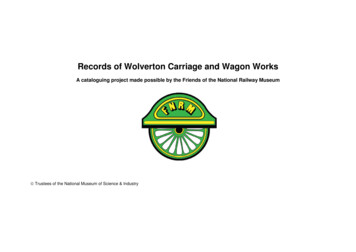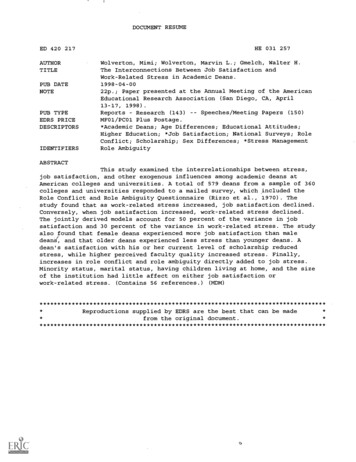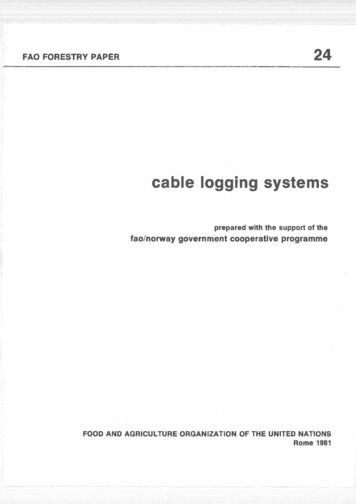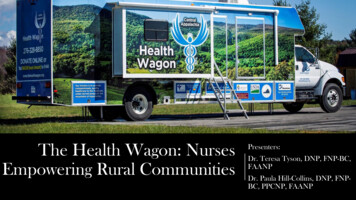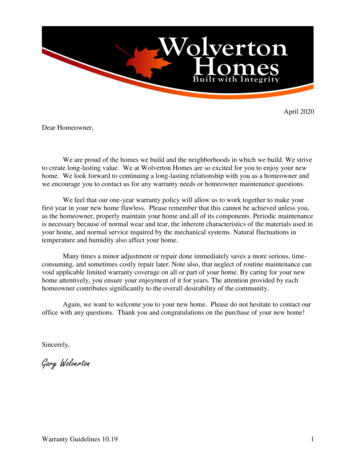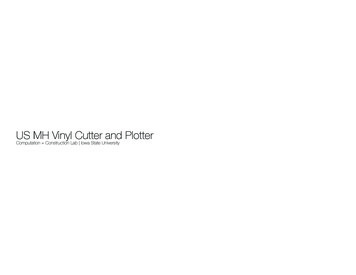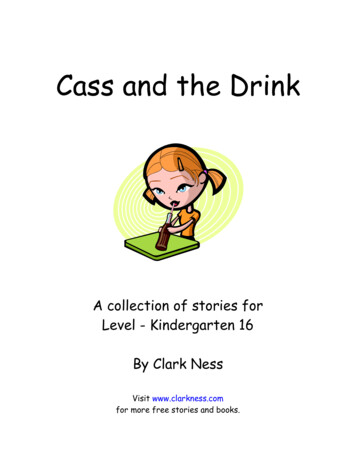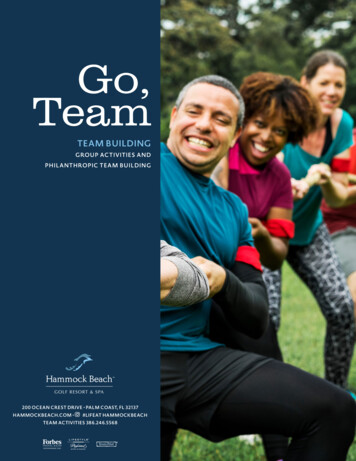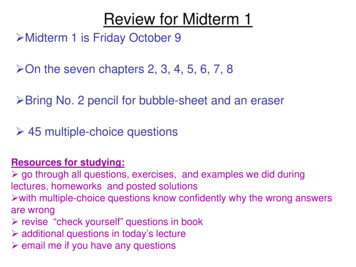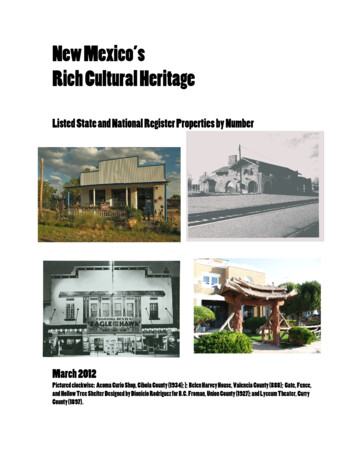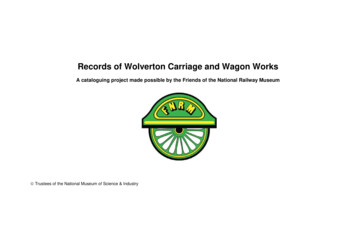
Transcription
Records of Wolverton Carriage and Wagon WorksA cataloguing project made possible by the Friends of the National Railway Museum Trustees of the National Museum of Science & Industry
Contents1. Description of Entire Archive: WOLV (fonds level description)Administrative/Biographical HistoryArchival historyScope & contentSystem of arrangementRelated units of description at the National Railway MuseumRelated units of description held elsewhereUseful Publications relating to this archive2. Description of Management Records: WOLV/1 (sub fonds level description)Includes links to content3. Description of Correspondence Records: WOLV/2 (sub fonds level description)Includes links to content4. Description of Design Records: WOLV/3 (sub fonds level description)Includes links to content5. Description of Production Records: WOLV/4 (sub fonds level description)Includes links to content6. Description of Workshop Records: WOLV/5 (sub fonds level description)Includes links to content
1. Description of entire archive (fonds level description)TitleFonds reference codeDatesExtent & Medium of the unit of theunit of descriptionName of creatorsRecords of Wolverton Carriage and Wagon WorksGB 0756 WOLV1831-199387 drawing rolls, fourteen large archive boxes, two large bundles, one wooden box containing glass slides, 309standard archive boxesWolverton Carriage and Wagon WorksAdministrative/Biographical HistoryOrigin, progress, developmentWolverton Carriage and Wagon Works is located on the northern boundary of Milton Keynes. It was established in1838 for the construction and repair of locomotives for the London and Birmingham Railway. In 1846 The Londonand Birmingham Railway joined with the Grand Junction Railway to become the London North Western Railway(LNWR). The works became the LNWR Engine Works and continued construction and repair of locomotives until1865. In 1877 locomotive work ceased and was transferred to the LNWR Crewe works. Wolverton became theLNWR Carriage Works, taking over the role from Saltley Carriage Works, Birmingham. By 1907 Wolverton was thelargest building and repair works in Britain; between 1900 and 1924 4500 staff worked there.In 1923 railway companies in Britain were amalgamated into four main railway companies. The LNWR wasamalgamated into the London Midland and Scottish (LMS) railway company and the works became the LMSCarriage and Wagon Works, Wolverton. Works activities were extended to include new wagon construction.During World War One and World War Two British railway companies were temporarily taken under control by theGovernment. Companies were given a dispensation to undertake work on behalf of overseas railways or otherorganisations at home or abroad. During World War Two Wolverton repaired Whitley bombers, produced sections ofHorsa gliders, and converted nearly 700 commercial motor vans into armoured vehicles.In 1948 the railways were nationalised and Wolverton continued to operate as a major works under British Railways(BR). In 1962 all main BR works (at this point known as British Rail) were rationalised and Wolverton became acarriage repair works only, the site was reduced in size by 30 per cent. From 1970 onwards the works was operatedby British Rail Engineering Limited (BREL). From 1986 BREL was altered to form two separate divisions withWolverton becoming under the jurisdiction of British Rail Maintenance Ltd (BRML). British Rail was privatised in1993, the site was owned by Alstom until the mid 2000’s, the site is now operated by Railcare.
Administrative structureThere is no documentation in this archive to show how the works was run in its very early days, however we knowthat the works was managed by a Superintent and it is likely that foremen or workshop supervisors controlled workon the shop floor. During the LNWR period (1846-1923) the works was organised into departments under theSuperintendent, namely; Accountant, Correspondence Clerk, Chief Draftsman, Works Manager, Storekeeper andOutdoor Assistant Departments. These were then subdivided into teams of clerks, assistants etc. Under thesedepartments were workshops and their staff, this would have been where the majority of staff members worked. Formore detail see London and North Western Railway Society Organisational Chart, Carriage Department (WOLV1/3/3).When the LNWR was amalgamated into the LMS the works was controlled by the LMS Chief Mechanical Engineer(CME). The LMS introduced a functional type of works organisation – all planning for new manufacture wasundertaken in the Production Planning Office, which meant that little office work was carried out in the workshops.This is reflected in the small amount of documentation in originating directly from workshops in this archive.Under Nationalisation some staff at Wolverton were under the jurisdiction of the Chief Mechanical and ElectricalEngineer (CM&EE). These staff were responsible for examining rolling stock and had input into the design process.All other members of staff worked for the Workshops Division. Control functions in BREL workshops were similar tothat of LNWR and LMS structure with departments for production, accounts, and personnel.Other informationWolverton was one of the first ‘Railway towns.’ Initially gas and water was supplied by company as well as the worksfire brigade. In 1901 a central power station was designed by Works Superintendent C.A. Park and Wolvertonbecame the first railway works to adopt electric lighting and machinery driving throughout. From 1919-1926 theworks ran the Wolverton and Stony Stratford Tram, which was the last steam tramway to operate in Britain.Wolverton developed a single battery system that was designed to replace gas lighting in carriages. This became thestandard for the LNWR and the LMS and was known as the ‘Wolverton System’ of train lighting. From 1950 BRcarriages were fitted with more modem batteries and by 1964 the Wolverton system began to be replaced with otherdesigns.
Archival historyTransfer of materialThe bulk of the archive was transferred to the National Railway Museum in 1986 directly from Wolverton Carriageand Wagon Works. However some records originating from Wolverton reached the National Railway Museumthrough different routes and have been reunited with Wolverton material to form this archive.Some publications (WOLV 1/6/1/4-13) were transferred from Wolverton Carriage and Wagon Works to the BritishRailways Board Record Centre in London. These were subsequently transferred to the National Railway Museum,dates unknown.Early locomotive drawings (WOLV 3/1) were transferred to the National Railway Museum from the former Museumof British Transport, Clapham, in 1975, along with drawings of other provenance (NRM inventory number 19967911). It is likely that they were transferred to Clapham from Crewe or directly from Wolverton, date unknown.A proportion of the main series drawings (WOLV 3/2) were transferred to the National Railway Museum from theformer Museum of British Transport, Clapham; there they were grouped into an ‘LMS series’. All drawings from the‘LMS series’ that originated from Wolverton have now been added to the archive. These drawings form part of themain series drawings but have been distinguished with ‘LMS’ in the reference code.Some photograph albums (WOLV 3/5) were removed from a ‘Misc’ photograph album series held at the NationalRailway Museum. It is likely that some of these albums may have originated from Derby, however for ease ofreference these have been added to the Wolverton archive.Absent materialThis archive does not contain all records from Wolverton Carriage and Wagon Works, many would have beentransferred to other owners or destroyedAccording to a letter in the Stephenson Locomotive Society Magazine 1955 and 1956 (see Useful Publicationsrelating to this archive) there was a fire in J.E. McConnel’s Offices (Locomotive Superintendent of the SouthernDivision at Wolverton 1847-1862) at Wolverton in1855 which may have destroyed records. During World War TwoWolverton destroyed paper records as part of a national paper salvage drive.
Material originating from other corporate bodiesSome records from other corporate bodies have become part of the archive. This is because they were transferredto Wolverton for operational use during the works existence.The drawing collection contains records from private companies and other railway works (WOLV 3/1, WOLV 3/2).The collection includes stock books from Saltley (WOLV 1/1/1), which were presumably transferred to Wolverton foradministrative purposes when Saltley ceased carriage production. There are also records from Newton Heath andEarlestown such as diagram books (WOLV 3/3), and correspondence regarding staff from the British Railways ChiefAccountant’s Office Manchester (1960’s-1970’s) (WOLV 4/8/12).Scope & contentOrganisational subdivisionsThe archive is split up into organisational subdivisions as follows, follow links for more detailed descriptionsWOLV/1 Management recordsWOLV/2 Correspondence recordsWOLV/3 Design recordsWOLV/4 Production recordsWOLV/5 Workshop recordsThe following themes are represented throughout the archiveManufactureThe archive contains records covering all main functions of the works from the 1830s to the 1990s. It contains somerecord of nearly all vehicles produced at Wolverton. Detailed information on vehicles can be found in drawings(WOLV 3/1, WOLV 3/2), these drawings often show vehicles and material that was designed but never actuallymanufactured. The archive also contains an almost full set of drawing registers from 1886 that run until the 1980s.(WOLV 3/4). These record all drawings produced at Wolverton, even if the drawings themselves have not beenpreserved.
More information can be found from other sources including correspondence (WOLV/2), reports (WOLV 1/5, WOLV1/14), order for new stock/specification files (WOLV 3/9) and photograph albums (WOLV 3/7) as well in filesconcerning building programmes (WOLV 4/4), condemnation (WOLV 4/10), and accounting and financial records(WOLV 4/8). Where possible lot numbers, drawing numbers and correspondence reference numbers have beenreferenced. This means that different types of record can be cross-referenced with each other.The archive contains core records such as Stock Books that list stock built at the works from the 1840s to the 1910s(WOLV 1/1). After this it is possible to ascertain what stock was built at Wolverton through the ‘order for new stock’files and specifications (WOLV 3/7). The archive contains experiment files showing tests carried out on stock atWolverton (WOLV 4/9/3).Later manufacture is covered in the Drawing Office project files (WOLV 3/11). Programmes such as the constructionof newspaper vans and EMUs for Northern Ireland in the 1980s are described in these files. They also coversubjects such as the control of asbestos (WOLV 3/11/3/2/72).Staff RecordsThe archive does not contain official staff records; however records relating to staff are spread throughout thearchive. Some examples of where information on staff can be found are as follows: reports to the LocomotiveCommittee (WOLV 1/5) contain various references to staff, for example members of staff involved in accidents,undergoing disciplinary procedures, deceased, or serving in wartime; drawing registers (WOLV 3/4) containphotographs of staff members and biographical information next to the last drawing produced by them; the archivecontains a small number of references written for staff members (WOLV 1/3/4); staff time books (WOLV 5/4) andpiece work rate books (WOLV 4/8/6) show when staff were employed, what they did and information on pay; royaltrain files include some information on members of staff employed on the royal train (WOLV 3/10. WOLV 2/1);workshop records (WOLV/5) focus heavily on staff information; the ‘Staff Particulars’ volume (WOLV 5/1) containsnames and addresses of staff showing where staff lived in proximity to the works; the register entitled ‘sick’ (WOLV5/2/6) records staff member’s time taken off and their illness.Wartime recordsThe archive contains records from the Boer War to World War Two. There are drawings showing stock built duringwartime throughout the main series drawings (WOLV 3/2); there are however few files relating to World War One inthe archive, possibly because of World War Two paper salvage drives. Reports to the Locomotive Committee(WOLV1/5) contain lists of men serving in wartime in the Boer War and World War One; staff time books (WOLV 5/4)
show which staff members were conscripted and sometimes staff members who did not return from wars. There is alarge series of Air Raid Precautions files (WOLV2/6) that cover how the works planned to protect itself from air raidsduring World War Two. One works book from 1918 (WOLV 4/5/1/1) describes how the works disinfected Chineselabour trains.There are a large number of drawings of ambulance trains both for World War One and World War Two, dispersedthrough the main drawings series (WOLV 3/2). Some of these show components that make up carriages e.g.ashtrays, equipment, and some show the whole layout of the train and labels who would reside in each carriage;diagrams of ambulance trains can also be found in diagram books (WOLV 3/3). Photograph albums show theoutside and inside of ambulance trains WOLV (3/7).Royal Train RecordsDrawings of royal trains (often named ‘special trains’) exist throughout ‘main series’ drawings (WOLV 3/2). Thesespan from Queen Adelaide’s saloon (even though this was not built at Wolverton) and Queen Victoria’s saloon up tomodern saloons from the BR period, including vehicles now in the National Collection.Drawings from main series (WOLV 3/2) show the formation of trains on royal train journeys and where members ofstaff and the monarch would have been on the train; diagram books (WOLV 3/3) also contain layouts of royalsaloons.Files from the Drawing Office (WOLV 3/10) and correspondence files (WOLV 2/1) deal with a wide range of topicsincluding staff, members of the royal family and government who travelled on the trains, wartime travel, and detailsof specific journeys. Files compiled by the Drawing Office (WOLV 3/10/1) describe who was travelling on the royaltrain on certain journeys.Files also detail fixtures and fittings in carriages and how they were painted, as well as technical information coveringthe construction and modification of carriages. The correspondence file on the fire in the trimming shop (WOLV 2/5)describes a fire at the works in 1933 where local people and staff saved the royal train from damage, this includespress articles and personal message of thanks from the King. Photograph albums show pictures of royal vehiclesincluding photographs of them under construction.National CollectionThe archive contains records relating to objects in the National Collection including records on royal train carriagesat the National Railway Museum. These can mostly be found in the main series drawing collection (WOLV 3/2) and
in royal train files (WOLV 2/1, WOLV 3/10); there is a file covering the Duke of Sutherland’s Saloon (WOLV 2/18)which describes how it was transferred to the British Transport Commission instead of being sold, subsequentlycoming to the National Railway Museum. There are also files regarding the carriages to be pulled by the FlyingScotsman 1966-1969 (WOLV 3/11/3/2/57), carriages for the Coronation Scot service including an ‘order for newstock/specification’ file (WOLV 1/11), photographs (WOLV 3/7/1/5) and information on budgets (WOLV 4/7/1/9).‘One off’ RecordsThe archive contains some ‘one off’ records that were presumably kept because they were deemed of historicalinterest. One of the oldest records in the collection is a letter from W.M.C. [surname illegible, possibly Coston],Blisworth, to Mr Fitzsimons, Wolverton (WOLV 1/3/1) from 1879, which appears to have been deliberately preserved.WOLV 1/4/3/11 contains two photographs of unnamed soldiers who presumably were members of staff. Recordshave been preserved from the LNWR Wolverton Savings Bank (WOLV 1/2), some of which have been photocopied,suggesting they were deemed ‘valuable’.Some records are clearly part of a larger series and may have been retained accidently e.g. a volume containingreferences and paperwork received for newly employed staff members (WOLV 1/3/4) (this only covers two years);however the rest of the series has been lost.Appraisal, destruction andscheduling informationSamplingRecords that form part of repetitive file series and contain low level information have been sampled.Equipment/Machinery files (‘D’ Series) (WOLV 4/6), Modification/repair cards (WOLV 4/7/4) and piece work pricecards (WOLV 4/8/16) have been randomly sampled. For more information see series descriptions.DuplicationRecords that are duplicated have been removed, except when their duplication is significant. For example thedocument ‘British Railways Board Workshop Division: Re-Organisation of Wolverton Works as Part of the OverallWorkshops Plan’ is found more than once in the archive (WOLV 1/6/3/3, WOLV 1/14/1/7,8).Duplicated diagram books (WOLV 3/3) have been removed; the copy with the most amount of information retained.Duplicated photograph albums have been removed (WOLV 3/7); duplicate copies minutes that are held at TheNational Archives have been removed (WOLV 4/11).
Low level recordsVery low level record have also been removed, for example low level correspondence; scraps of paper from files,information duplicated in higher level records.Published materialPrinted material, for example BR publications and manuals, that are likely to be duplicated elsewhere have beenremovedNo accruals expectedAccrualsSystem of arrangementThe majority of the archive appears to have originated from the Drawing Office and associated design offices with,other records originating from the Production Offices, General Management and Workshops. Arrangement isfunctional; records of the same functional activity have been grouped together into categories based onorganisational provenance, using organisational charts, records and coding systems within the archive. Recordseries have been arranged chronologically for ease of reference.Most of the archive is described to item level; sometimes component parts of the item are described to piece level.Some parts of the archive are described to sub-series level only. Some descriptions jump from fonds to item level,because there is only one item in the series.Some file series covering similar subjects are found in separate administrative sub fonds, e.g. files regarding theroyal train are found in design (WOLV 3/10) and correspondence (WOLV 2/1). This is because although these filesrelate to the same subject they were used by separate administrative sub-divisions.Each sub fonds description show how each sub fonds has been arranged.Conditions governing accessAccess is given in accordance with the National Railway Museum access policy. Material form this archive isavailable to researchers through the Search Engine reading room. Some records in the archive are subject to accessrestrictions in line with the Data Protection Act 1998. Where restrictions are in place this is indicated next theseries/item description.Conditions governing reproductionCopies may be supplied of items in the archive, provided that the copying process used does not damage the item or
is not detrimental to its preservation. Copies will be supplied in accordance with the National Railway Museum’sterms and conditions for the supply and reproduction of copies, and the provisions of any relevant copyrightlegislation.LanguageEnglish, small amount of shorthandPhysical Characteristics &technical requirementsMaterial mainly comprises paper, with some folders and volumes bound in leather. Drawings are usually on waxedlinen although some are on tracing paper or are blueprint/dyeline copies. Some items have been repackaged witharchival acid free paper and folders to minimise damage to records.Where there are specific technical requirements these are listed alongside the item or series description.Finding aidsThis catalogue acts as the finding aid to this collection, reference numbers are provided for each item.Existence and location of originalsItems in the archive are originals unless otherwise stated.Existence and location of copiesNo known copies of archive material have been produced to dateRelated units of description at theNational Railway MuseumAs well as records and items listed below, objects relating to Wolverton Works are found the National RailwayMuseum Fixtures and Fittings from Railway Buildings, Passenger Comforts, Railway Furniture, Railway Heraldry,Railway Infrastructure, Railway Timepieces, Railway Uniform and Costume, and Tools of the Trade and PersonalAccessories collections.For further information please contact the National Railway Museum archive and library centresearch.engine@railwaymuseum.org.uk.Records from Plaistow workTransferredtoWolvertonandthensubsequently transferred to the NationalRailway Museum. There is a finding aidavailable.2000-8465Register of drawings, no 1-2314, December 1876-August 1913, from Plaistow Works, 1 volume.
2000-84641992-763Drawings, Plaistow Works[Engineering drawing of 4-coupled bogie tank of the London, Tilbury and Southend Railway / Tho.Whitelegg. 1907 Mar 11. Ink and wash on paper, scale 1" : 1'. Bears stamp of Plaistow Works, No.1434 and signature of Thomas Whitelegg. He was locomotive carriage, wagon and marinesuperintendent of the L.T. & S. Ry. from 1879 to 1910]
Items that have been accessioned into theNational Railway Museum archive collectionfrom private -8224/12003-83462003-83512003-83582004-8382Papers relating to work carried out at Wolverton Works on the carriages which accompanied the FlyingScotsman to the United States. Contains memoranda, notes and copy drawings. Kept in greencardboard fileLabel for railway carriage, London & North Western Railway, Queen Victoria's Saloon, built WolvertonWorks, 1869, headed 'Carriage & Wagon Engineer's Department, Works Superintendent's Office,Wolverton'.Inventory of loose furniture and equipment for railway carriage, London & North Western Railway,Queen Victoria's Saloon, built Wolverton Works, 1869, headed 'London Midland and Scottish RailwayCompany, Chief Mechanical Engineer's Department, Loco. Works Supt's Office, Derby 4th September1933'.Membership card and rule book for the London Midland & Scottish (LNW) Insurance Society Rules,1929 issued to Mr Arthur William Nicholls, Joiner, Wolverton. Admitted to the Society on 4 May 1939,membership number 458874.Collection of pay slips and appointment papers belonging to Mrs G Whitton (nee Nicholls), ClericalOfficer for British Railways, Wolverton Carriage & Wagon Works Wages Office, 1950-1958, HemelHempstead/Watford 1958-1987.1 volume, London, Midland & Scotland Railway (LMS) 'LM&SR Special Saloons', Chief Mechanical &Electrical Engineer's Department, Wolverton.Note paper, London & North Western Railway carriage department, Wolverton station, A.R. Trevithick,191 , (Other Associations 80/25/79).2 notices, London & Birmingham Railway, Notice of a meeting at the Town Hall Buckingham, 31 March1838, To discuss the railroad station at Wolverton, (Other IDs 76/25/632).Notice, London & Birmingham Railway, Notice of a meeting at the Town Hall Buckingham, 31 March1838, To discuss the railroad station at Wolverton, (Other IDs 76/25/632).Leaflet, South Eastern & Chatham Railway Timetable, Royal train, 28 November 1899, The GermanEmperor & Empress, From Wolverton to Port Victoria, (Other IDs 77/43/15).Leaflet, South Eastern and Chatham and Great Eastern Railway, Time table of the train conveying HisImperial Majesty The German Emperor, From Port Victoria to Shorncliffe, From Shorncliffe toWolverton, Saturday 8 November 1902, (Other IDs 77/43/25).Leaflet - timetable, Great Eastern Railway, Royal Train 28 November 1899, Conveying GermanEmporer & Empress, Wolverton to Victoria, (Other IDs 77/43/9).Railway Executive (London Midland Region) instruction book for the "Wolverton Train Lighting System
2008-8458Photographs1996-73111996-7312WOL 1-1320WNT 4-1318Type "M. D."", 3rd edition, February 1949. 16 typed pages and 1 fold-out diagram.Illuminated address, paper, leatherette with silk inlay, to the chairman and directors of the London andNorth Western Railway Company given by the members of the Superannuation fund of WolvertonCarriage and wagon works officers, foreman and workmen on the occasion of the "Opening of the Parkand Recreation Ground", 1885.Series of approximately 485 8½ x 6½ ins (wholeplate) glass negatives dating c.1928-1936. These arenumbered between W1 and W2026 .Two handwritten registers dating from the LMS period listing most of the 8½ x 6½ ins wholeplatenegatives in 1996-7312 (above). One is a sequential numerical listing of negatives between W1 andW818, the other an alphabetical breakdown of the same negatives.Approximately 140 12 x 10 ins glass negatives dating c.1903-1926. Refernenced by a WOL referencenumber Some of these negatives have Derby numbers (prefixed ‘DY’) in addition to the WOL referencenumber. Part of same series as WNT negatives (below).There is a paper list for most of this series, Wolverton Works, Register of Official PhotographicNegatives, LNWR & LMS, 1903 – 1932 (paper copy of handwritten register)Approximately 750 12 x 10 ins glass negatives from the WTN series, date c.1903 to 1926. At the endof the sequence are about 100 additional negatives, which have no WOL or DY numbers, and havetherefore been numbered by the National Railway Museum. Part of same series as WOL negatives(above)These form part of 1995-7233, the accession of a huge collection of official negatives from a variety ofcompanies, also known as the Oxford Publishing Company (OPC) or Railprint collection after it wasmarketed by British Rail in the 1980s. It was stored for some time at Blythe House.1995-72332004-77052004-7706Listed in a photocopied register Wolverton Works, Register of Official Photographic Negatives, LNWR& LMS, 1903 – 1932 (paper copy of handwritten register)Official negatives from a variety of companies, also known as the Oxford Publishing Company (OPC) orRailprint collection after it was marketed by British Rail in the 1980s, these are 100 additionalphotographs added onto the WTN series above.Photograph, group, Wolverton Works Ambulance Team, Winners LMS Championship 1932, in glazedframe, 380mm x 305mm.Photograph, aerial view of BREL Wolverton Works, c. 1985, in glazed frame, 380mm x 325mm.
2006-7442Photograph, framed, group photograph, Works Superintendent, Assistants and Foremen, BritishRailways Carriage and Wagon Works, Wolverton, October 6th 1949, with key.Pictorial 841978-18911978-18941978-19061978-191314 Lithographed views of the London and Birmingham Railway when in course of construction, 1837:Euston Square Depot; Hampstead Road Bridge; Bridge over Regents Canal; Camden Town Depot;Watford Embankment & Colne Valley; Colne Viaduct near Watford; Nash Mill Bridge; BerkhamsteadCutting and train; Tring Cutting; Making the embankment, Wolverton Valley; Wolverton Viaduct;Blisworth Cutting; Avon Viaduct, Woolston; Sherborne Viaduct near Coventry.Lithograph. London and Birmingham. 'Wolverton Viaduct', August 1837. Drawn and lithographed by J CBourne. Printed by C Hullmandel. Published by J C Bourne, 19 Lamb's Conduit St, and Ackermann andCo, Strand, London. 1839.Lithograph. London and Birmingham Railway. 'Making the Embankment, Wolverton Valley, 28 June1837'. Drawn and lithographed by J C Bourne. Printed by Day and Haghe, Lithographers to the Queen.Published by J C Bourne, 19 Lamb's Conduit St and Ackermann and Co, Strand, London. July 1838.Lithograph. London and Birmingham Railway. 'Wolverton Viaduct, August 1837'. Drawn andlithographed by J C Bourne. Printed by Day and Haghe, Lithographers to the Queen. Published by J CBourne, 19 Lamb's Conduit Street, and Ackermann and Co, Strand, London.Lithograph. London and Birmingham Railway. 'Making the Embankment, Wolverton Valley, 28 June1837'. Drawn and lithographed by J C Bourne. Printed by Day and Haghe, Lithographers to the Queen.Published by J C Bourne, 19 Lamb's Conduit Street, and Ackermann and Co, Strand, London. July1838.Lithograph. London and Birmingham Railway. 'Wolverton Viaduct, August 1837'. Drawn andlithographed by J C Bourne. Printed by Day and Haghe, Lithographers to the Queen. Published by J CBourne, 19 Lamb's Conduit St and Ackermann and Co, Strand, London.Lithograph. Specimen of Bourne's sketches on the London and Birmingham Railway. 'Making theEmbankment, Wolverton Valley, 28 June 1837'. Drawn and lithographed by J C Bourne. Printed by Dayand Haghe, Lithographers to the Queen. Published by J C Bourne, 19 Lamb's Conduit St andAckermann and Co, Strand, London.Lithograph. London and Birmingham Railway. 'Wolverton Viaduct, August 1837'. Drawn andlithographed by J C Bourne. Printed by Day and Haghe, Lithographers to the Queen. Published by J CBourne, 19 Lamb's Conduit St and Ackermann and Co, Strand, London.Lithograph. London and Birmingham Railway. 'Making the Embankment, Wolverton Valley, 28 June1837'. Drawn and lithographed by J C Bourne. Printed by Day and Haghe, Lithographers to the Queen.Published by J C Bourne, 19 Lamb's Conduit St and Ackermann and Co, Strand, London. 1838/07.
ailway Maps and Plans1998-8576Lithograph. London and Birmingham Railway. 'Wolverton Viaduct, August 1837'. Drawn andlithographed by J C Bourne. Printed by Day and Haghe, Lithographers to the Queen. Published by J CBourne, 19 Lamb's Conduit St and Ackermann and Co, Strand, London.Litho
Wolverton developed a single battery system that was designed to replace gas lighting in carriages. This became the standard for the LNWR and the LMS and was known as the 'Wolverton System' of train lighting. From 1950 BR carriages were fitted with more modem batteries and by 1964 the Wolverton system began to be replaced with other designs.
